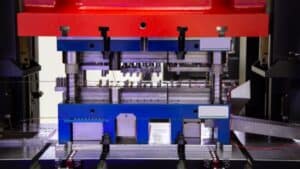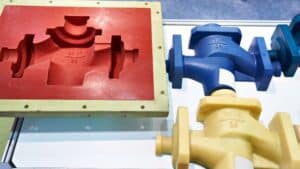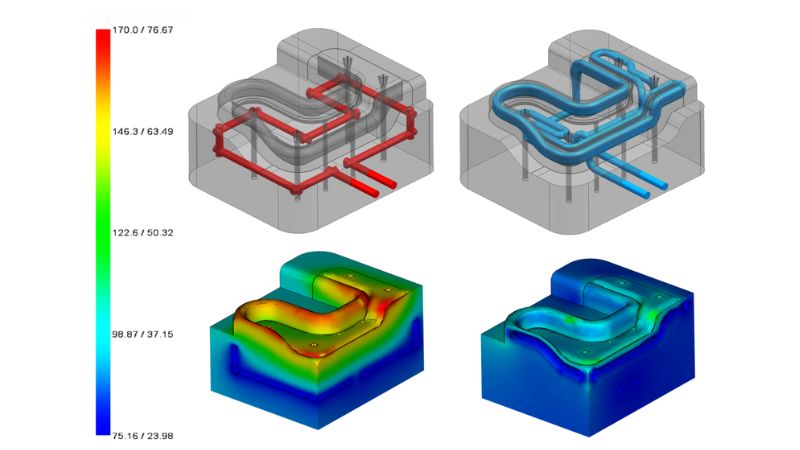
Why Cooling a Mold is Important?
Keeping the cost per unit low in injection molding heavily depends on reducing cycle time, which spans from plastic injection to part ejection.
Efficient cooling is critical, as parts must cool to 80% of their Heat Deflection Temperature (HDT) to prevent warping or defects, and cooling channels must be strategically placed to ensure even and rapid heat transfer using turbulent flow.
Poor cooling can lead to internal stresses, surface defects, and dimensional inconsistencies, ultimately increasing scrap rates and costs.
Here is a table to help you how to choose from conformal cooling and traditional cooling:
| Aspect | Conformal Cooling | Traditional Cooling |
|---|---|---|
| Design | Follows the contour of the mold cavity and core. | Uses straight, drilled cooling channels. |
| Cooling Efficiency | Highly efficient; uniform cooling across the part. | Less efficient; uneven cooling in complex geometries. |
| Cycle Time | Reduces cycle time significantly. | Longer cycle time due to less efficient cooling. |
| Complexity | Requires advanced design and manufacturing (e.g., 3D printing). | Simple and straightforward to design and manufacture. |
| Part Quality | Minimizes warping, sink marks, and residual stress. | Higher risk of warping and defects in complex parts. |
| Applications | Ideal for complex geometries and high-volume production. | Suitable for simpler parts and low-volume production. |
| Maintenance | May require specialized maintenance. | Easier to maintain and repair. |
| Material Compatibility | Works well with a wide range of materials. | Works well with standard materials. |
| Tool Life | Potentially longer due to uniform cooling. | Shorter tool life in high-stress applications. |
Overview of Conformal Cooling
Conformal cooling is a specialized cooling technique primarily used in injection molding processes.
Unlike conventional cooling channels that follow straight lines, conformal cooling channels are designed to follow the exact shape or “conform” to the geometry of the part being molded.
The basic principle is simple but powerful – by placing cooling channels closer to the heat source and following the part’s contours, heat transfer becomes more efficient. These channels are typically created using additive manufacturing, like 3D printing technologies that allow for complex internal structures.
This cooling method gets its name because the cooling paths literally “conform” to the part’s design rather than forcing the part to work with straight-line cooling paths, which ensures more consistent cooling throughout the mold, reducing hot spots and improving overall temperature control.
Benefits of Conformal Cooling
First, cycle times can be significantly reduced. Because heat transfers more evenly and efficiently, parts cool faster and can be ejected sooner.
Part quality also improves dramatically. With more uniform cooling, you’ll see fewer defects like warping, sink marks, and internal stresses. This leads to more consistent part dimensions and better surface finishes.
Production efficiency increases as well. The faster cycle times mean you can produce more parts in the same amount of time, boosting your overall productivity.
Mold longevity is another benefit. More even cooling reduces thermal stress on the mold itself, potentially extending its useful life. Though initial costs for conformal cooling are higher, the long-term savings from faster cycles and higher quality parts often provide an excellent return on investment.
Understanding Conventional Cooling Systems
Conventional cooling systems have been the industry standard in plastic injection molding for decades.
Conventional cooling typically relies on straight-line drilled channels that run parallel to the mold surface. These channels contain water or other coolants that absorb heat from the molten plastic during the injection process. The coolant flows through these channels in a circuit, removing heat as it travels.
Most conventional systems use a network of these straight channels connected by plugs and manifolds. The design is limited by drilling technology, which can only create straight paths. Water enters the mold through inlet ports, flows through the cooling channels, and exits through outlet ports.
Challenges with Conventional Methods
Despite their widespread use, conventional cooling systems face several significant limitations. The most obvious challenge is that straight-line cooling channels cannot follow the contours of complex part geometries. This creates uneven cooling with hot spots in areas where channels cannot reach.
You’ll notice longer cycle times with conventional cooling because heat removal is less efficient. Parts may cool at different rates, leading to quality issues like warping, sink marks, and internal stresses.
Another problem is the limited ability to place cooling channels near critical features. For complex parts, some areas remain far from any cooling channel. This distance reduces cooling efficiency and extends production times.
Comparative Analysis of Cooling Techniques
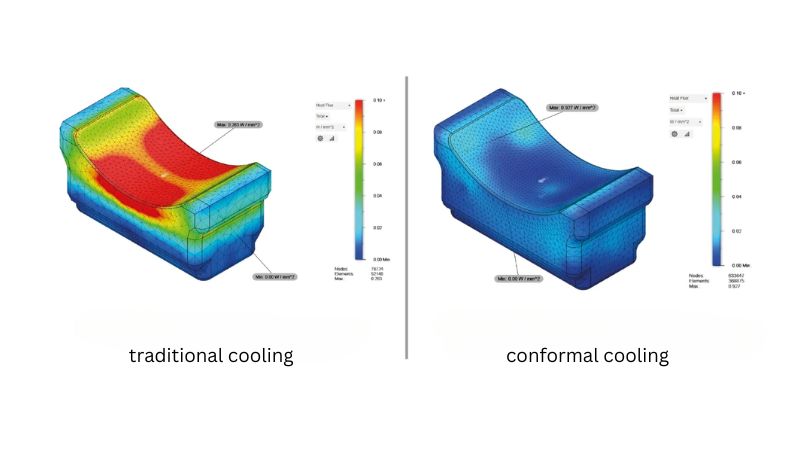
Quality of End Products
Conformal cooling channels follow the exact shape of the part, providing more uniform cooling throughout the mold
Research shows that parts cooled with conformal channels show approximately 160% more heat removal than those with conventional systems. This means your parts maintain better dimensional accuracy and surface finish.
Quality Comparison:
- Conformal: More uniform cooling, fewer defects, better dimensional stability
- Conventional: Uneven cooling patterns, higher risk of warping and sink marks
Cycle Time Efficiency
By conforming to the part’s geometry, these channels remove heat more efficiently. This means your mold reaches optimal ejection temperature faster than with conventional cooling.
Studies indicate cycle time reductions of 15-40% when switching to conformal cooling. For high-volume production, this translates to substantial productivity gains over time.
Your conventional cooling setup might be sufficient for simple parts, but as complexity increases, the efficiency gap widens dramatically.
Technological Advances in Conformal Cooling
3D Printing Innovations
Metal 3D printing, especially selective laser melting (SLM), lets you build molds with cooling channels that follow the exact shape of your part. This wasn’t possible with traditional drilling methods.
The accuracy of 3D printers has improved too. Modern machines can create channels with very precise dimensions, sometimes as small as 0.5mm in diameter.
Material Science Developments
New materials have made conformal cooling more effective and durable. High-conductivity copper alloys can remove heat up to 5 times faster than standard mold steels.
Composite materials that combine good heat transfer with excellent wear resistance are now available. These materials last longer in production environments while maintaining cooling efficiency.
Surface treatments like specialized coatings help prevent corrosion and scaling inside cooling channels. This keeps your cooling system working efficiently for longer periods.
Some newer materials can even be “graded” – meaning they have different properties in different areas of the same mold. You might have high wear resistance at the mold surface but excellent heat conductivity near cooling channels.
These material advances make conformal cooling systems more reliable and cost-effective over the long term.
Case Studies on Conformal Cooling Implementation
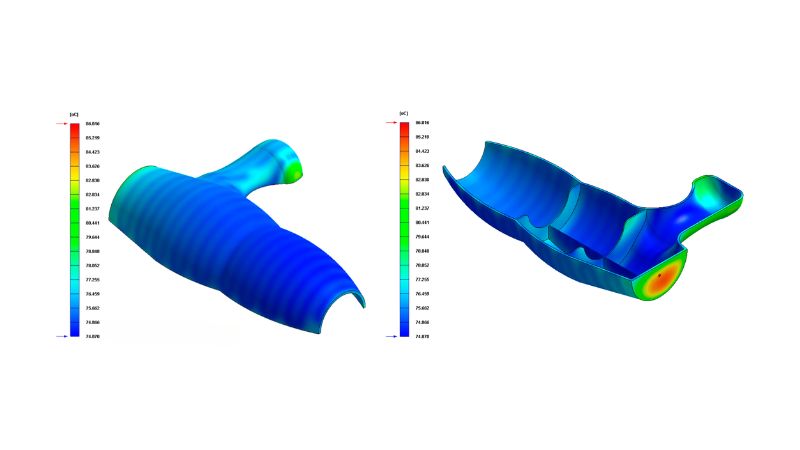
Automotive Industry Applications
BMW implemented conformal cooling in their engine component molds and saw a 28% reduction in cycle time. This allowed them to produce more parts per day while maintaining excellent quality standards.
Toyota used conformal cooling channels in their dashboard mold designs. The results were striking:
- 40% faster cooling times
- 25% less warpage in finished parts
- More consistent part quality across production runs
Ford Motor Company reported energy savings of 15-20% after switching to conformal cooling for their door panel production. Their engineers noted that the improved temperature control also reduced reject rates by nearly a third.
GM’s implementation for bumper components eliminated hot spots that previously caused quality issues. You can expect similar improvements when applying this technology to complex automotive parts.
Energy Consumption
Conformal cooling channels reduce cycle times by up to 40% compared to conventional cooling.
When your molds cool more efficiently, you need less power to run injection machines and cooling systems.
For a mid-sized production facility, these energy savings can add up to thousands of dollars annually.
Material Waste Reduction
Conformal cooling creates more consistent temperatures across mold surfaces. This consistency means fewer defects like warping, sink marks, and short shots in your finished products.
When you produce fewer defective parts, you throw away less material.
Less waste means:
- Reduced raw material purchases
- Lower disposal costs
- Smaller environmental impact
- Better use of precious resources

